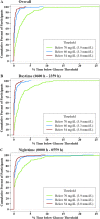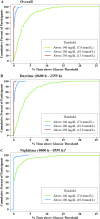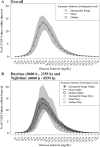Continuous Glucose Monitoring Profiles in Healthy Nondiabetic Participants: A Multicenter Prospective Study
- PMID: 31127824
- PMCID: PMC7296129
- DOI: 10.1210/jc.2018-02763
Continuous Glucose Monitoring Profiles in Healthy Nondiabetic Participants: A Multicenter Prospective Study
Erratum in
-
Corrigendum to: Continuous Glucose Monitoring Profiles in Healthy Nondiabetic Participants: A Multicenter Prospective Study.J Clin Endocrinol Metab. 2022 Mar 24;107(4):e1775-e1776. doi: 10.1210/clinem/dgab837. J Clin Endocrinol Metab. 2022. PMID: 34888657 Free PMC article. No abstract available.
Abstract
Context: Use of continuous glucose monitoring (CGM) is increasing for insulin-requiring patients with diabetes. Although data on glycemic profiles of healthy, nondiabetic individuals exist for older sensors, assessment of glycemic metrics with new-generation CGM devices is lacking.
Objective: To establish reference sensor glucose ranges in healthy, nondiabetic individuals across different age groups using a current generation CGM sensor.
Design: Multicenter, prospective study.
Setting: Twelve centers within the T1D Exchange Clinic Network.
Patients or participants: Nonpregnant, healthy, nondiabetic children and adults (age ≥6 years) with nonobese body mass index.
Intervention: Each participant wore a blinded Dexcom G6 CGM, with once-daily calibration, for up to 10 days.
Main outcome measures: CGM metrics of mean glucose, hyperglycemia, hypoglycemia, and glycemic variability.
Results: A total of 153 participants (age 7 to 80 years) were included in the analyses. Mean average glucose was 98 to 99 mg/dL (5.4 to 5.5 mmol/L) for all age groups except those over 60 years, in whom mean average glucose was 104 mg/dL (5.8 mmol/L). The median time between 70 to 140 mg/dL (3.9 to 7.8 mmol/L) was 96% (interquartile range, 93 to 98). Mean within-individual coefficient of variation was 17 ± 3%. Median time spent with glucose levels >140 mg/dL was 2.1% (30 min/d), and median time spent with glucose levels <70 mg/dL (3.9 mmol/L) was 1.1% (15 min/d).
Conclusion: By assessing across age groups in a healthy, nondiabetic population, normative sensor glucose data have been derived and will be useful as a benchmark for future research studies.
Copyright © 2019 Endocrine Society.
Figures



References
-
- Nathan DM, Genuth S, Lachin J, Cleary P, Crofford O, Davis M, Rand L, Siebert C; Diabetes Control and Complications Trial Research Group. The effect of intensive treatment of diabetes on the development and progression of long-term complications in insulin-dependent diabetes mellitus. N Engl J Med. 1993;329(14):977–986. - PubMed
-
- DeSalvo DJ, Miller KM, Hermann JM, Maahs DM, Hofer SE, Clements MA, Lilienthal E, Sherr JL, Tauschmann M, Holl RW, Exchange TD, Registries DPV; T1D Exchange and DPV Registries. Continuous glucose monitoring and glycemic control among youth with type 1 diabetes: International comparison from the T1D Exchange and DPV Initiative. Pediatr Diabetes. 2018;19(7):1271–1275. - PMC - PubMed
-
- Borg R, Kuenen JC, Carstensen B, Zheng H, Nathan DM, Heine RJ, Nerup J, Borch-Johnsen K, Witte DR, Group AS; ADAG Study Group. Real-life glycaemic profiles in non-diabetic individuals with low fasting glucose and normal HbA1c: the A1C-Derived Average Glucose (ADAG) study. Diabetologia. 2010;53(8):1608–1611. - PMC - PubMed
Publication types
MeSH terms
Substances
Grants and funding
LinkOut - more resources
Full Text Sources
Other Literature Sources
Medical
Research Materials
Miscellaneous

